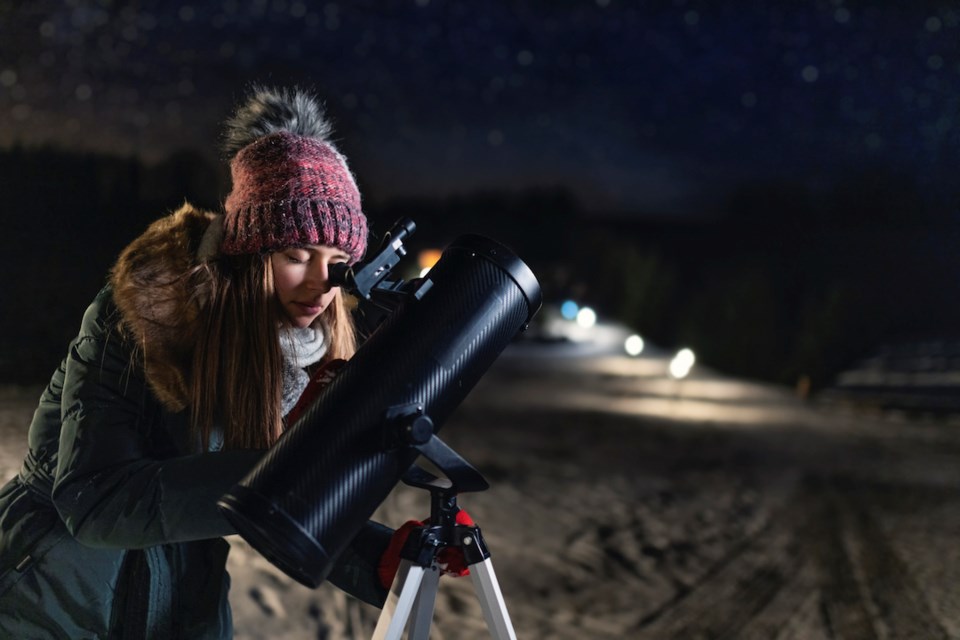The interesting planetary slow dance before sunrise continues during June.
At 0430, at the start of the month, Venus will be in the ESE, about 6 degrees above the horizon; Mars and a close Jupiter are about 15 degrees high and Saturn about 20 degrees, aligned at an angle of about 30 degrees to the horizon to the west (right) of the sun. By the end of the month, Jupiter will have moved west and up to about 30 degrees above the SE horizon and Saturn about 26 degrees above the southern horizon. This line of planets is fairly close to the ecliptic, the path we see the sun take through the sky as we orbit it. Although most planetary orbits are tipped slightly to the ecliptic, they do stay pretty close to the plane of our orbit.
Being able to see four visible planets in a line is impressive but what I find even more impressive is that with a pair of binoculars you can also find Uranus about 40 per cent of the way from Venus to Mars. With a small telescope you can also see Neptune about 30 per cent of the way from Jupiter to Saturn. Uranus is just below naked-eye visibility at mag. 6.6 and Neptune is fainter at just about 8.2. So, that’s almost every planet in the solar system since Pluto got voted off the island a few years back. The only one missing is Mercury, which went through inferior conjunction – between us and the sun – on May 21. Wait until mid-June, however, and Mercury will begin to appear above the morning horizon just north of due east, below and left of Venus. Although the two outermost planets, Uranus and Neptune, are in the line, they’re not in order out to the right of Saturn. However, the naked-eye planets, Mercury, Venus, Mars, Jupiter and Saturn, innermost to outermost, are in a row from lower left to upper right and they will all move in nearly the same line of the ecliptic over the course of the month. I can’t remember the last time we had this kind of panorama of planets in the sky.
Just to make it entirely obvious, a waning moon will pass below (south) of Saturn on June 18, Jupiter and Mars on June 21 and 22 respectively and just north (above) Venus and Mercury on June 26 and 27 respectively. This will be a tough act to follow, certainly, unless another comet zooms by or Betelgeuse goes supernova or the like.
For those not especially thrilled about getting up at oh-dark-thirty to watch planets rise, there is more and more to see in our clearing evening skies. As the solstice approaches, a couple of important landmark stars appear to the SSE. At 2230 on June 1, the Big Dipper will be high in the west with the star at the end of the handle, Alkaid, almost exactly straight overhead. Starting at the connection to the bowl, follow the arc of the handle stars through Alkaid about twice the length of the handle to another bright star high in the south, Arcturus. Remember “arc to Arcturus.” It’s the brghtest star in Bootes, about 37 lightyears distant and about 10 per cent more massive than our sun. However, it’s estimated to be 5 to 7 billion years old and has expanded to become a red giant about 25 times the sun’s diameter. If the helium in its core hasn’t ignited yet – the helium flash – to fuse into carbon, etc. it’s very close. It’s a preview of what our sun will become in another 2 to 3 billion years.
From Arcturus, continue in the same arc about as far again to the next bright star, Spica, the brightest star in Virgo. Remember “speed on to Spica.” Spica is about 250 lightyears distant and quite unlike Arcturus. For starters it’s a binary system comprised of two young hot B-type stars of about 11 and 7 solar masses, respectively. They’re so close to each other, their orbital period is about four days and the stars are egg-shaped. Since the primary appears to be large enough to go out as a supernova in some few million years or so, this system will likely be a very interesting place to watch. From a safe distance, that is – perhaps 250 lightyears is about right.
From Arcturus, some of our best naked-eye summer sights are easily found and more with binoculars. Spica is the neighbourhood of many, many deep sky objects, some of which are also good in binoculars. These will be the starting points for the subjects of next month’s celestial travelogue.
For information on the Astronomy Club’s next meeting – Zoom or in person – on June 10 please check out the club website at: https://sunshinecoastastronomy.wordpress.com/. Charles Ennis will be the speaker on the “World Asterisms Project.”
Editor's note: The subheading in a previous version of this story said you'd need a "small microscope" to see Neptune. It is in fact a telescope you'll need.



